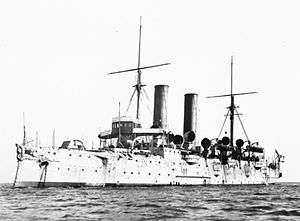Blake-class cruiser
 HMS Blenheim | |
| Class overview | |
|---|---|
| Name: | Blake class |
| Operators: |
|
| Preceded by: | Orlando class |
| Succeeded by: | Edgar class |
| Completed: | 2 |
| General characteristics [1] | |
| Type: | First class protected cruiser |
| Displacement: | 9,150 long tons (9,300 t) |
| Length: | |
| Beam: | 65 ft (19.81 m) |
| Draught: | 24 ft (7.32 m) |
| Propulsion: |
|
| Speed: |
|
| Capacity: | 1800 tons coal |
| Complement: | 570 |
| Armament: |
|
| Armour: |
|
The Blake class was a two-ship class of first-class protected cruiser built around 1890 for the Royal Navy.
Design
The Blake class were designed under the supervision of William White, shortly after he had become Director of Naval Construction. They were planned to combine the roles of trade protection with the ability to operate with the fleet when required. As such, the design requirement combined high speed and long range. Unlike the previous class of first-class cruisers for the Royal Navy, the Orlando class, the new class were protected cruisers, with protection provided by a full-length armoured deck with no side armour. They were the first class of first-class cruisers built for the Royal Navy.[1][2]
Main gun armament was similar to that of the Orlandos, consisting of two 9.2 in (234 mm) Mark VI breech loading guns mounted in single mounts fore and aft on the ship's centreline, and ten 6 in (152 mm) QF guns, of which six were mounted in single mounts on the ships' top deck and the remaining four mounted behind armoured casemates on the ships' main deck. Secondary armament consisted on sixteen 3 pounder guns. Four 14 inch torpedo tubes completed the ships' armament, with two submerged tubes and two above the waterline. The arched armoured deck was at approximately the level of the waterline, with a thickness of 3 in (76 mm) at the centre and 6 in (152 mm) at the sides, while the ships' conning tower was protected by 12 in (305 mm) of armour. The 9.2 inch guns were behind 4.5 in (114 mm) gunshields while the casemates protecting the main deck 6 inch guns were 6 inch thick.[1]
Machinery consisted of 4 three-cylinder triple expansion engines fed by six double-ended cylindrical boilers and driving two shafts. The engines generated 13,000 indicated horsepower (9,700 kW) under natural draught and 20,000 indicated horsepower (15,000 kW) with forced draught, giving a speed of 22 knots (41 km/h; 25 mph) with forced draught and 20 knots (37 km/h; 23 mph) with natural draught. The forward two engines could be disconnected for longer endurance at low speeds. 1,800 long tons (1,800 t) of coal could be carried, double the fuel of the Orlandos, giving a range of 10,000 nautical miles (19,000 km; 12,000 mi) at 10 knots (19 km/h; 12 mph), which was much less than the 15,000 nautical miles (28,000 km; 17,000 mi) expected.[1]
Service
The two ships were obsolete by the outbreak of the First World War, and served as depot ships. HMS Blenheim had the more active career, supporting the Mediterranean Expeditionary Force at the Battle of Gallipoli, and repatriating three dignitaries to their home countries after their deaths abroad. They were Prince Henry of Battenberg and former Canadian Prime Ministers Sir John Thompson and Sir Charles Tupper.
Building Programme
The following table gives the build details and purchase cost of the members of the Blake class. Standard British practice at that time was for these costs to exclude armament and stores.
| Ship | Builder | Maker of Engines |
Date of | Cost according to | ||
|---|---|---|---|---|---|---|
| Laid Down | Launch | Completion | (BNA 1895)[3] | |||
| Blake | Chatham Dockyard | Maudslay | July 1888 | 23 Nov 1889 | 2 Feb 1892 | £440,471 |
| Blenheim | Thames Ironworks | Humphrys | October 1888 | 5 Jul 1890 | 26 May 1894 | £425,591 |
Notes
References
- Brassey, T.A. (ed) The Naval Annual 1895
- Brown, D.K. Warrior to Dreadnought: Warship Development 1860–1905. London: Caxton Editions, 1997. ISBN 1-84067-529-2.
- Colledge, J. J.; Warlow, Ben (2006) [1969]. Ships of the Royal Navy: The Complete Record of all Fighting Ships of the Royal Navy (Rev. ed.). London: Chatham Publishing. ISBN 978-1-86176-281-8. OCLC 67375475.
- Chesnau, Roger and Kolesnik, Eugene (Ed.) Conway's All the World's Fighting Ships, 1860–1905. Conway Maritime Press, 1979. ISBN 0-8317-0302-4
External links
| Wikimedia Commons has media related to Blake class cruiser. |